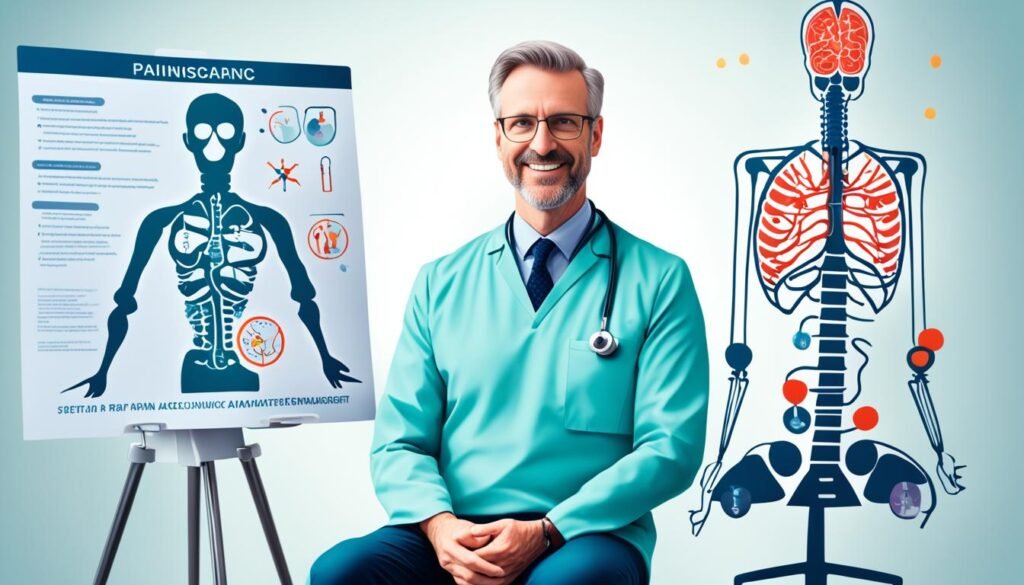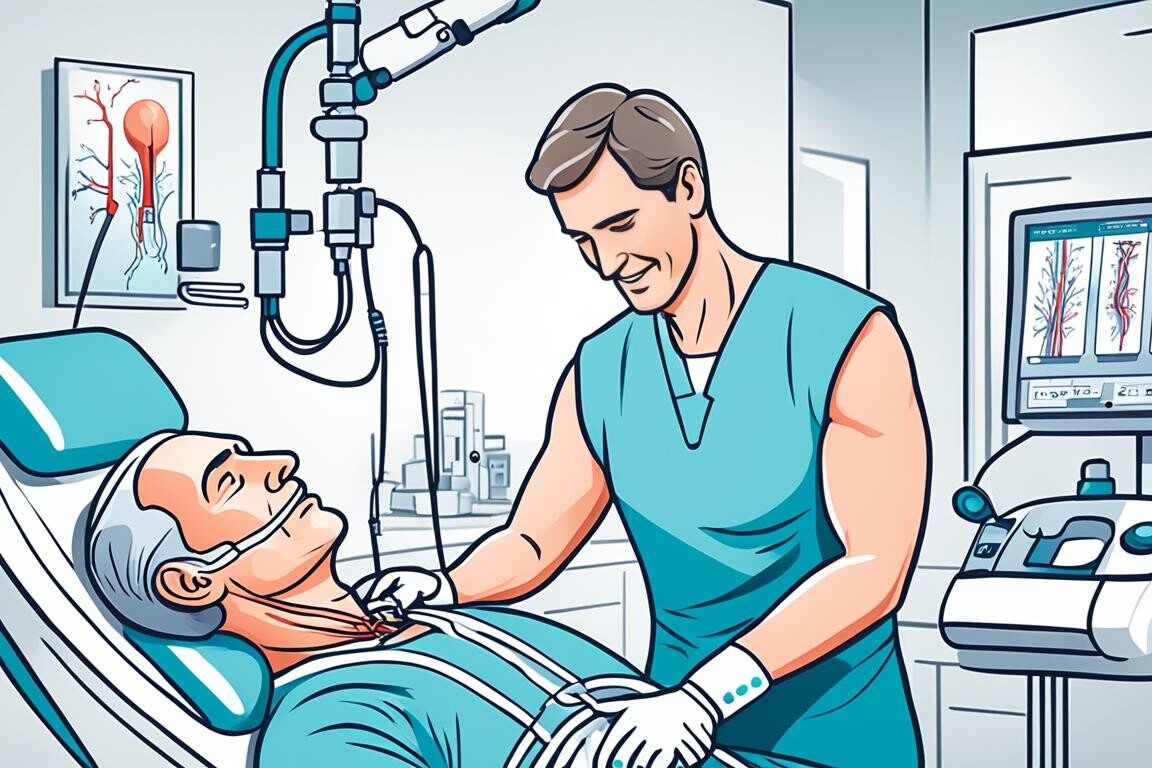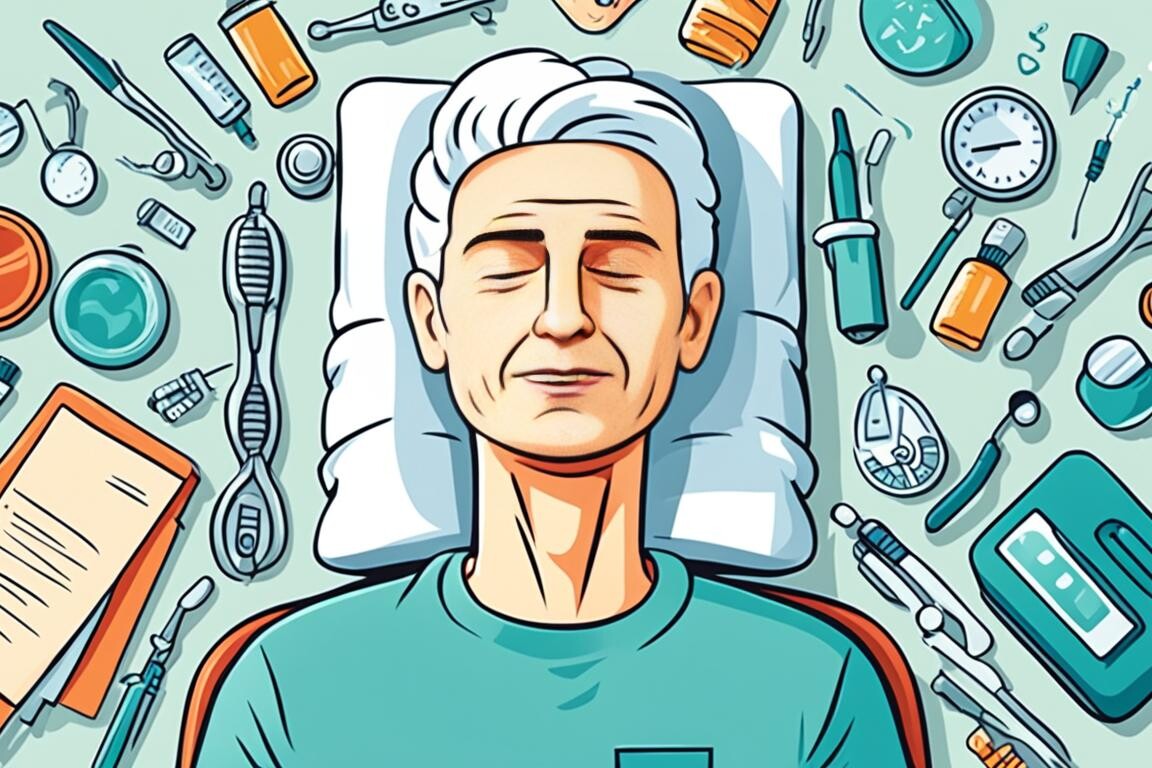If you’re dealing with chronic pain, a pain doctor can be a big help. They have the skills and knowledge to diagnose and treat different kinds of pain. This includes headaches, back pain, neck pain, and neuropathic pain, among others.
Pain doctors, or pain management specialists, have extra training after their medical school. They often focus on areas like anesthesiology, neurology, or physical medicine and rehabilitation. This extra knowledge lets them manage your chronic pain in a detailed way.
A pain doctor will work with you to make a treatment plan. This plan might include medicines, procedures, physical therapy, and other therapies. Their aim is to ease your pain, help you function better, and improve your overall health.
Table of Contents
ToggleUnderstanding Pain Management
What is Pain Management?
Pain management is a way to treat and manage pain, both acute and chronic. The main aim is to lessen, control, and help people cope with their pain. This improves their life quality. Pain management uses many methods, like medicines, procedures, physical and psychological therapies, and alternative therapies. Specialists in pain management work with patients to create plans that tackle the root causes of pain and offer lasting relief.
A 2018 review found that neuropathic pain affects about 7-8% of adults. Chronic pain, lasting 3-6 months or more, greatly affects life quality. Pain management doctors often need an extra year of training after medical school to specialize.
Pain is a common symptom of many injuries and conditions, from short-term to long-lasting pain. Chronic pain can last years and comes from various health issues, like arthritis, muscle injuries, autoimmune diseases, cancer, and spinal cord problems.

Anyone facing pain, whether new or ongoing, can benefit from a pain management plan. Pain management experts team up with a group that includes anesthesiologists, nurses, mental health professionals, physical and occupational therapists, social workers, and others. Together, they make plans tailored to each patient’s needs.
Chronic Pain and Its Impact
Chronic pain is a big issue that can really change how someone lives. It’s pain that lasts for 3-6 months or more. It can come from health problems, injuries, or chronic pain disorders. This pain does more than hurt; it can make moving hard, lower life quality, and increase healthcare costs.
People with chronic pain often feel constant or off-and-on pain, get tired easily, feel sad, and anxious. This makes doing everyday tasks hard, makes it tough to work and be social, and hurts their overall health. In fact, chronic pain is very costly in the U.S., causing high medical bills, lost wages, and less productivity.
Seeing a pain doctor is key to handling chronic pain and better living. Pain management plans often bring together many experts like neurologists, orthopedists, physical therapists, and psychologists. They work together to make a full treatment plan. This plan might include medicine, therapy, surgery, and support for the mind and feelings.
By tackling chronic pain from all angles, people can lessen the pain and feel more in charge of their health. With the right care and support, those with chronic pain can improve their physical, emotional, and social health. This helps them live a better life overall.

The Role of a Pain Doctor
Pain doctors, also known as pain management specialists, are experts in treating different types of pain. They know how complex pain works and create treatment plans for each patient. These specialists are key in helping people with chronic pain live better lives.
Expertise in Pain Management
Pain doctors get extra training in pain management after finishing their basic medical training. This training helps them handle a variety of pain issues, like arthritis and migraines. They work with other health experts, such as physical therapists and psychologists, to make a treatment plan for each patient.
These doctors are great at finding the cause of pain with tests and exams. They use things like neurological exams and imaging studies to figure out where the pain comes from. Then, they use different treatments, including medicines and procedures, to help manage chronic pain.
A big part of a pain doctor’s job is making sure all healthcare providers work together. This teamwork leads to a better, more complete treatment plan for chronic pain. It helps patients feel better and live fuller lives.

Types of Pain Treated by Pain Doctors
Pain doctors are experts in treating many types of pain. They help with chronic pain that lasts for months or years. They also treat neuropathic pain from nerve damage. Their goal is to relieve your pain and improve your life.
Chronic pain is a common issue they tackle. It’s pain that lasts 3-6 months or more. It can come from health issues or injuries. Pain doctors create custom plans to help manage this pain.
Neuropathic pain is another focus for them. It happens when the nervous system is damaged or doesn’t work right. This includes pain from diabetic neuropathy, trigeminal neuralgia, and spinal cord injuries. Pain doctors know how to treat this kind of pain.
They also treat nociceptive pain. This is pain from tissue damage, like injuries or arthritis. Their approach helps reduce this pain and boost your health.
Lastly, pain doctors are skilled in handling functional pain. This type of pain has no clear cause, found in fibromyalgia or irritable bowel syndrome. They work with you to create plans that cover both physical and emotional pain.
No matter the pain you face, pain doctors use a detailed approach. They assess, diagnose, and make custom treatment plans for you. Their expertise and commitment ensure you get the best care for your pain.
Comprehensive Pain Management Approach
Managing pain well often means using a team approach. Pain doctors, or specialists in pain management, work with others to give you the best care. This team includes anesthesiologists, physical and occupational therapists, psychologists or psychiatrists, nurses, and others.
Multidisciplinary Team
This team works together to make a plan just for you. They use proven methods to help you, focusing on your body, feelings, and mind. This way, your pain care is well-planned and covers all angles of chronic pain.
Places like Comprehensive Pain Management in Massachusetts and Rhode Island use this team approach. Dr. Chan and Dr. Shwartzman, who are experts in anesthesia and pain medicine, lead the team. They’ve been helping with pain for over 10 years.
Medical Management of Pain
Pain doctors use many medical treatments to help manage your pain. They might prescribe pain medications like opioids, NSAIDs, antidepressants, and anticonvulsants. These drugs aim to treat the underlying cause of your pain.
Medications and Interventions
Pain doctors also offer minimally invasive procedures. These include nerve blocks, epidural injections, or spinal cord stimulation. These methods target the pain source directly. They aim to lessen your need for oral pain medication.
When using opioid therapy, pain doctors are very careful. They know the risks of addiction and misuse. They work hard to balance pain relief with safety.
The right treatment depends on your pain type and severity, as well as your needs and wishes. Your pain doctor will work with you to create a treatment plan. This plan will address your specific pain concerns and offer the best relief.

Non-Pharmacological Therapies
Pain doctors often look beyond just giving medication for chronic pain. They see the value in using non-pharmacological therapies. These treatments can help traditional medicine and let patients take charge of their pain.
Physical therapy is a key therapy. It uses exercises, manual techniques, and other methods to improve strength, flexibility, and mobility. This can lessen pain and make daily activities easier. It helps patients live better lives and use less medication.
Psychological therapies like cognitive-behavioral therapy (CBT) are also vital. They help patients find ways to cope with pain and deal with the emotional side of it. This approach helps patients handle chronic pain better and feel better overall.
Other therapies like acupuncture, massage, and mindfulness are also used. They aim to balance energy, relax the body, and help it heal naturally.
The aim of these therapies is to give patients more control over their lives and cut down on medication use. With a pain doctor’s help, patients can try different options to find what works best for them.

Pain Doctor
Managing chronic pain can be tough, but a pain doctor can really help. They have a lot of training and certification in pain treatment. They know how to find the cause of pain and create treatment plans just for you.
Pain doctors get extra training, often for a year or more, in pain management. This training teaches them about the newest ways to treat pain. They learn about things like procedures, medicines, and non-drug therapies. Many are also board-certified in pain medicine or anesthesiology, keeping up with new research and training.
Comprehensive Pain Treatment Expertise
Pain doctors are experts in treating pain. They can figure out what’s causing your pain and make a detailed plan to fix it. They might use a team approach, including things like:
- Interventional pain procedures (e.g., nerve blocks, epidural injections)
- Medications and pain-relieving therapies
- Physical therapy and rehabilitation
- Alternative therapies (e.g., acupuncture, massage)
With their deep knowledge and experience, pain doctors can find the best pain management for you. This helps you take back control of your life.

Improving Quality of Life
Living with chronic pain can really change your life. It affects every part of your day. But, a skilled pain management doctor can help you take back control. They aim to reduce pain, cut down on medication, and help you do more in your daily life and with others.
Pain management doctors work with you to create a plan that covers your body, feelings, and social life. This plan might include medicine, physical therapy, and counseling. Their goal is to boost your ability to function and improve your life quality.
By finding and treating the causes of your pain, these doctors can help you move better, sleep better, and connect with others more. This approach to pain relief lets you play a big part in managing your pain. It helps you live a more independent and fulfilling life.
Remember, managing pain is not just about feeling less pain. It’s about living your life fully and finding new ways to enjoy activities. With help from a pain management expert, you can start moving towards a brighter and more meaningful future.
Personalized Treatment Plans
Managing chronic pain requires a tailored approach. Pain doctors create treatment plans that fit each patient’s unique needs and likes. They look at your medical history, symptoms, and goals to make a plan. This plan mixes different therapies to tackle your pain’s specific causes.
This approach might use medications, procedures, physical therapy, support, and other therapies. Doctors work with you to set goals and check your progress. They adjust the plan as needed to make sure you get the best care.
Personalized pain management is more than just treating symptoms. It looks at the deep causes of your pain, like muscle, nerve, or mixed issues. By understanding your experiences and what you prefer, doctors can make a detailed plan. This plan helps ease your pain and improve your life quality.
Your pain is special, and so should your treatment. Working with a pain doctor who focuses on personalized pain management is a big step towards better health and well-being.
Collaboration with Primary Care Providers
Pain management often needs a team effort between pain doctors and primary care providers. These healthcare workers team up to make sure patients get a full and coordinated plan for chronic pain.
Coordinated Care
Primary care providers are key in the first step of assessing and referring patients to pain management experts. After a patient sees a pain doctor, these teams work together. They share info, plan treatments, and keep an eye on the patient’s progress. This teamwork makes sure all parts of the patient’s health are looked at and avoids any care issues.
By working as a team, primary care and pain doctors can offer the best care for those with chronic or complex pain. This way of caring for patients improves their outcomes and makes their lives better.
- Pain doctors and primary care providers work together to share info and plan treatments.
- This teamwork ensures a full and smooth patient care experience.
- Working together helps avoid care problems and betters patient results.
The partnership between pain doctors and primary care providers is key in handling chronic pain. This teamwork leads to a detailed and tailored treatment plan. It looks at the patient’s physical, emotional, and overall health. By working together, these professionals can offer the best pain management and improve the life quality of those with chronic pain.
Ongoing Monitoring and Adjustment
Pain management is a process that changes over time. It needs close watching and regular changes to your treatment plan. Your pain doctor will work with you to check how well your treatments are working. They will look for any changes in your condition and adjust your treatment as needed.
This might mean changing how much medicine you take, trying new procedures, or adding other therapies that don’t involve drugs.
Your doctor will keep an eye on how you’re doing and involve you in making decisions. This way, your treatment plan will always match your changing needs. It will keep giving you the best pain management, relief, and better quality of life.
- Regular checks to see if your current treatment is working well
- Finding changes in your pain and adjusting treatments as needed
- Working with you to make sure your treatment fits your changing needs
- Keeping a close watch to give you the best pain management, relief, and better life quality
With this detailed and team effort, your pain doctor can guide you through the changing world of pain management. They make sure you get care that’s made just for you and is very effective.
Access to Advanced Treatments
When dealing with ongoing or severe pain, seeing a specialized pain doctor can lead to many advanced treatment options. These doctors have access to special procedures and the newest in pain management. This includes things like nerve blocks, spinal cord stimulation, and radiofrequency.
Pain doctors keep up with the newest research and trials. This lets them offer new therapies and treatments. They use the resources and knowledge at pain clinics to give care that fits each person’s needs and likes.
The Department of Pain Management at MGM Healthcare uses the latest robotic technology for non-surgical treatments. Dr. R Madhan Kumar, a top pain doctor, leads the Center for Advanced Pain Management. He works with a team to make treatment plans for each patient.
These plans might use different medical treatments, psychological help, and rehab. The center offers many interventional treatments. This includes things like epidural steroid injections, selective nerve root blocks, and facet injections.
By getting help from a pain doctor, people with ongoing or severe pain can get the newest in pain management. This care can greatly improve their life, work, and overall well-being. It’s a big step towards better health and happiness.
Support and Education
Pain doctors know how key it is to support and educate patients with chronic pain. They aim to make patients active in their care. This helps them feel in control and boosts their well-being.
Through education, pain doctors teach patients about their pain and treatment options. They focus on non-pharmacological therapies that can fit into daily life. This way, patients learn to manage their pain better, leading to better outcomes.
Pain doctors also look at the emotional and mental sides of chronic pain. They offer counseling and support groups. These resources help patients deal with the tough parts of living with pain.
By educating and supporting patients, pain doctors help those with chronic pain take charge of their health. This teamwork approach builds trust and leads to safer, more effective pain care.
Conclusion
Pain doctors are key in helping people with chronic pain. They use a full approach to manage pain and boost life quality. This includes looking at physical, emotional, and mental sides of pain.
They combine medical treatments, non-drug therapies, and support to help patients take charge of their health. This helps them lessen pain and get better at doing daily tasks.
For those with chronic pain, seeing a pain doctor is a big step towards better health and a happier life. These doctors know how to tailor treatments to each patient’s needs. This helps patients manage their pain better and live more fully.
The need for skilled pain doctors is growing, seen in hospitals and government health centers. This shows how important it is to focus on pain care that puts the patient first. It helps people with chronic pain live healthier lives.
FAQ
What is a pain doctor?
A pain doctor, also known as a pain management specialist, is a medical expert. They focus on treating different kinds of pain, especially chronic pain. They use a special approach to manage pain.
What is the goal of pain management?
The main goal of pain management is to lessen and control pain. This improves a person’s life quality. It uses many methods, like medicines, procedures, therapy, and alternative treatments.
What is chronic pain?
Chronic pain lasts for more than 3-6 months. It can come from health issues, injuries, or chronic pain conditions. It affects a person’s health, feelings, and social life.
What types of pain do pain doctors treat?
Pain doctors treat many pain types, like chronic, neuropathic, and functional pain. They use a team approach to find and treat pain. They create treatment plans that fit each patient’s needs.
How do pain doctors work as part of a multidisciplinary team?
Pain doctors work with a team that includes many healthcare experts. This team helps create a treatment plan that suits the patient’s needs. They work together to help patients manage their pain better.
What types of medical interventions do pain doctors use?
Pain doctors use various treatments, like medicines and procedures. They choose the best treatment based on the patient’s pain type and needs.
What non-pharmacological therapies do pain doctors incorporate?
Besides medicines, pain doctors use therapies like physical and psychological therapy. These help patients manage pain and improve their life quality.
What qualifications do pain doctors have?
Pain doctors have special training and certification in pain management. They complete extra training after medical school, often in a fellowship program.
How do pain doctors work with a patient’s primary care provider?
Pain doctors work with primary care providers for better pain management. They share information and coordinate treatment plans. This ensures patients get the best care.
How do pain doctors ensure ongoing monitoring and adjustment of treatment plans?
Managing pain is ongoing. Pain doctors regularly check how well treatments work and adjust them as needed. They make sure the treatment fits the patient’s changing needs.
What types of advanced treatments do pain doctors have access to?
Pain doctors offer advanced treatments not found in primary care. They use their expertise and clinic resources for the best care possible.
How do pain doctors empower and support their patients?
Pain doctors help patients by teaching them about their pain and treatment options. They support patients in using non-medical therapies to manage pain.
Source Links
About The Author

This article is medically reviewed by Dr. Chandril Chugh, Board-Certified Neurologist, providing expert insights and reliable health information.
Dr. Chandril Chugh is a U.S.-trained neurologist with over a decade of experience. Known for his compassionate care, he specializes in treating neurological conditions such as migraines, epilepsy, and Parkinson’s disease. Dr. Chugh is highly regarded for his patient-centered approach and dedication to providing personalized care.
→ Book a consultation to discover which remedies suit your needs best.




